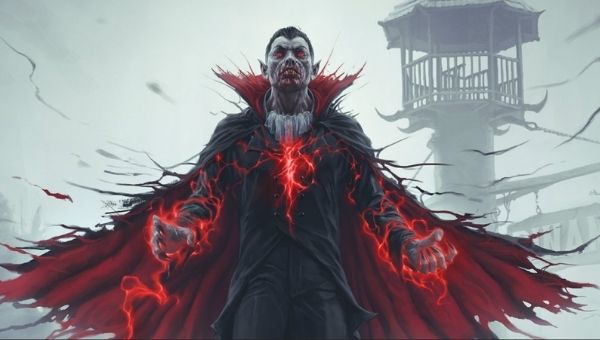Complete History of Vampires: We all have been quite obsessed with Robert Pattinson since Twilight was released. We have all been fascinated by Dracula. So, what is the real deal with blood-sucking creatures? In this article, we are going to read about the origin of vampires. So that we can have a clear picture of its origin and the reason behind its influence on screen and in art as well. We all know that vampire exists by feeding on strong essence especially the blood of living beings. It is a creature from folklore, in European folklore vampires are immortal creatures that frequently visited their loved ones and cause trouble or feed on the neighbourhood they chose to reside in. As described in folklores, vampires used to wear shrouds and were often defined as bloated, ruddy, and dark countenance. The description of folklore is quite dissimilar from the 19th-century description of vampires.
Origin of Vampires | Complete History of Vampires:
Etymology of Vampire
The word ‘vampire’ first appeared in English as ‘vampyre’ in the year 1732 in news reports about epidemics in the eastern part of Europe. The topic of vampires had already been discussed in German and French literature. In 1718 officials noted the unearthing of corpses and killing of vampires after Austria gained control over Oltenia and northern Serbia with the Treaty of Passarowitz. The English term possibly derived from the French term ‘vampyre’ which appeared from the German term ‘vampir’, which derived from Serbian ‘vampir’ in the early 18th century. The exact etymology of this word is unclear. Another widespread theory is that Slavic languages have borrowed this word from the Turkic term ‘witch’.
Folk Beliefs And Vampire
Cultures such as Ancient Greeks, Mesopotamians, Manipuri, Hebrews, and Romans had tales of spirits and demons which are considered the predecessors to vampires. The belief in vampires became so pervasive at one point that in some areas it caused public executions of people who are thought to be vampires and mass hysteria. It is not possible to make out descriptions of vampires that are described in folklores however they were quite similar to the ones portrayed in European fiction. They were usually ruddy, dark in color, and bloated in appearance. Blood seeping from the mouth and when one was seen in its coffin, the left was often open. Teeth and nails have grown somewhat but fangs were never a feature essentially. Although vampires are defined as immortals, some folklore spoke of them as living beings.

In Chinese and Slavic traditions any dead body that was jumped over by an animal, especially a dog or cat was feared to be a vampire. And, also a body that had not been treated with boiling water was feared to become one of the undead. In Russian folklore, vampires were believed to have been once witches or humans who stood against the Russian Orthodox Church when they were alive.
There were several processes to identify a vampire as well. One of the methods was to lead a virgin boy through a church or graveyard grounds on a virgin stallion – the horse would allegedly balk at the grave in question. In general, a black horse is used but in Albania, the horse should be white. Holes appearing on the ground of the grave were taken as symbols of vampirism. Evidence that a vampire is alive in the coffin includes the death of sheep, cattle, neighbours, or relatives. Folkloric vampires could also make their existence felt by involving in certain minor activities, such as pressing on people in their slumber, moving household objects, or hurling stones on roofs.
Vampires are believed to be incapable of walking on sacred grounds or crossing running water. Some apotropaic include garlic, wild rose, hawthorn, mustard seeds, and other common usages were holy water, crucifix, and rosary. Some traditions believe that vampires cannot enter a household unless invited, once after their first invitation they can come and go according to their wish. In ancient folklore, vampires were active in the night-time just like in the 19th-century description but they were not vulnerable to sunlight.

Vampire Beliefs
Paul Barber in his book Vampires, Burial and Death has elucidated that belief in vampires concluded from people of pre-industrial societies trying to clarify the natural, but to them incomprehensible, the process of death and decay. People sometimes suspected that vampires appear from their graves because their bodies did not decompose in the right way. The dead bodies swell as gases from decay accumulate in the torso and the added pressure compels blood to ooze out from the mouth and nose. This is why the vampire is portrayed as well-fed, ruddy, or plump. One such case was of Arnold Paole, an old woman’s unearthed corpse that was defined as more healthy and plump than she looked when she was alive. The blood coming out of the mouth gave the impression of a recent vampiric act.
The darkening of the skin is also a cause of decomposition. The staking of a distended corpse could cause the body to bleed and force the buildup of gases to escape the body. After death, the gums and skin lose contact and fluids, exposing the nails, teeth, roots of the hair, and even the teeth that are hidden in the jaw. This produces the illusion that the nails, teeth, and hair have grown.

There was another theory that vampires appear when individuals are buried alive due to the inadequacy of medical knowledge of that time. In a few cases, people reported sounds coming out of specific coffins, and after digging up fingernail marks were seen. In other cases, victims would hit their faces, head, or noses. An issue with this theory is the question of how the victim managed to stay alive in the coffin for so long. The possible cause of the sound is the bubbling of escaping gases coming out from the bodies due to decomposition.
Origin of Vampires in Modern Fiction And Literature
Talking about the History of vampires in literature: Although, presently it is quite common topic in popular fiction. The fiction that proposed vampires began with poetry in the 18th century and it continued with the short stories of the 19th century. The first and the most influential work were written by John Polidori’s 1819 published The Vampyre featuring the vampire named Lord Ruthven. His exploits were further discussed in a series in which Ruthven was portrayed as an antihero. The theme of vampires continued with serial publications such as 1847 published Varney the Vampire and the most renowned work of vampire literature – the 1897 published novel Dracula by Bram Stoker.
With time some aspects became common regarding vampires such as vulnerability to sunlight, fangs, and protruding teeth. Count Orlok of 1922 published Nosferatu by Murnau feared sunlight. Varney and Count Dracula both had protruding teeth. The vampire cloak appeared in a 1920s stage production written by playwright Hamilton Deane so that vampires can vanish on stage. There was no written account of moonlight healing vampires in traditional folklores but Lord Ruthven and Varney were able to heal on moonlight. Even the immortality of vampires was not explicitly documented although implied in folklore, it is a feature that has been hugely used in literature and films.

The vampire first appeared in poems such as The Vampire written by Heinrich August Ossenfelder, Die Braut von Corinth written by Johann Wolfgang von Goethe, Lenore written by Gottfried August Burger, The Spectral Horseman written by Percy Bysshe Shelley, The Vampyre written by John Stagg, and other writers such as Samuel Taylor Coleridge, Robert Southey, Lord Byron, and more. Lord Byron was also credited with the first prose The Vampyre published in 1819; it was originally authored by Byron’s physician John Polidori. The character of Lord Ruthven was inspired by Byron’s lover Lady Caroline Lamb’s gothic fantasy roman-a-clef Glenarvon based on Byron’s wildlife. It was a highly popular and influential work of the early 19th century.
Varney the Vampire was a popular gothic horror work of the mid-Victorian era by James Malcolm Rymer and Thomas Peckett. Like Varney, Carmilla the popular lesbian vampire written by Sheridan Le Fanu was portrayed in a rather sympathetic light. Bram Stoker’s Dracula was portrayed in a different light as vampirism is a disease of infectious demonic control with its undertones of blood, sex, and death. In the 20th century, the vampire was introduced in Barnabas Collins by Marilyn Ross, Anne Rice’s Vampire Chronicles, and more. In the 21st century vampire is portrayed in literature by Stephenie Meyer’s Twilight, Richelle Mead’s Vampire Academy, L.A. Banks’ series of The Vampire Huntress Legend, Laurell Hamilton’s Anita Blake, J.R. Ward’s Black Dagger Brotherhood series, and more.
Also Read: Shortlisted Books for International Booker Prize 2022



